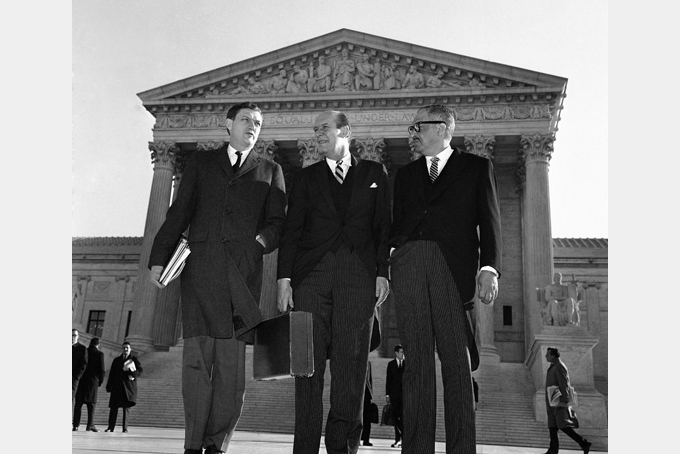
In this Jan. 17, 1966, photo then Solicitor Gen. Thurgood Marshall, right, Attorney Gen. Nicholas Katzenbach and Asst. Attorney Gen. John Doar arrive at the U.S. Supreme Court to defend the legality of the 1965 Voting Rights Act. (AP Photo, File)
by Mark Sherman
WASHINGTON (AP) — In roughly 75 hours of arguments at the Supreme Court since October, only one African-American lawyer appeared before the justices, and for just over 11 minutes.
The numbers were marginally better for Hispanic lawyers. Four of them argued for a total of 1 hour, 45 minutes.
Women were better represented, accounting for just over 17 percent of the arguments before the justices.
In an era when three women, a Hispanic and an African-American sit on the court and white men constitute a bare majority of the nine justices, the court is more diverse than the lawyers who argue before it.
The arguments that took place from October to April were presented overwhelmingly by White men. Women and minority lawyers whose clients’ cases were heard by the court were far more likely to represent governments or be part of public-interest law firms than in private practice, where paychecks are much larger.
The numbers generally reflect the largely White and male upper reaches of the biggest and richest private law firms, where there have been small gains by women and minorities in the past 20 years. A recent survey by the Association for Legal Career Professionals found that more than 93 percent of partners in law firms are White and nearly 80 percent are men.
The statistics from the court term, though, also reveal a lack of African-American and Hispanic lawyers in the elite Justice Department unit that represents the federal government at the Supreme Court.
The top supervisory positions in the Office of the Solicitor General all are held by men, though there are six women in the office who argued high court cases this term.
The office serves as a pipeline to the big firms that dominate the argument calendar at the court. Lawyers in the office make several arguments a term and acquire the experience and ease of standing before the justices that make them attractive to private firms.
The first woman on the court, Sandra Day O’Connor, touched on the importance of diversity at the court in a tribute to the first African-American justice, Thurgood Marshall. O’Connor said Marshall “imparted not only his legal acumen but also his life experiences, constantly pushing and prodding us to respond not only to the persuasiveness of legal argument but also to the power of moral truth.”
The justices also benefit from seeing lawyers who don’t all look and sound the same, said Alan Jenkins, an African-American former Justice Department lawyer who argued four cases at the Supreme Court. “It’s especially true of people who appear before the Supreme Court because the court, as an institution, is intentionally set apart from the day-to-day life of the nation,” said Jenkins, executive director of the not-for-profit The Opportunity Agenda in New York.
The only minority group that could be said to be overrepresented was lawyers of Asian heritage. Seven men — three in private practice, Deputy Solicitor General Sri Srinivasan and two others at the Justice Department and a lawyer for the American Civil Liberties Union — made 17 arguments to the court. There has never been an Asian-American justice.
When Debo Adegbile stepped to the lectern in defense of a landmark voting rights law in February, he was the first — and as it turned out, the only — African-American to make a high court argument this term.
Adegbile until recently worked for the NAACP Legal Defense and Educational Fund, the famed public-interest law firm that mounted generations of civil rights challenges, including the landmark Brown v. Board of Education case that outlawed official segregation in public schools.
Before he became a justice, Marshall was the organization’s top lawyer and argued several high court cases.
Adegbile represented six African-American residents of Shelby County, Ala., which is challenging a key provision of federal voting rights law. Following Solicitor General Donald B. Verrilli Jr.’s more legalistic presentation, Adegbile pointed to recent examples of intentional voting discrimination in the South to highlight the ongoing need for the measure.
“This statute is in part about our march through history to keep promises that our Constitution says for too long were unmet,” he said.
Voting rights was the second of two high-profile cases about race at the court this term.
In the first, three White men made the arguments when the justices considered the fate of the University of Texas program that takes account of race in admissions.
Civil rights cases have historically given minority lawyers the greatest chance to argue before the court, but those cases have been in decline for some time at the Supreme Court.
“The more problematic question is, why is civil rights litigation one of the few pathways available to African-American litigators when clearly they have distinguished themselves?” Jenkins said.
Your comments are welcome.
Follow @NewPghCourier on Twitter https://twitter.com/NewPghCourier
Like us at https://www.facebook.com/pages/New-Pittsburgh-Courier/143866755628836?ref=hl